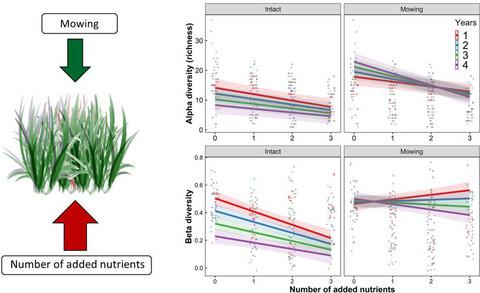Our official English website, www.x-mol.net, welcomes your
feedback! (Note: you will need to create a separate account there.)
Mowing does not redress the negative effect of nutrient addition on alpha and beta diversity in a temperate grassland
Journal of Ecology ( IF 5.3 ) Pub Date : 2020-12-19 , DOI: 10.1111/1365-2745.13573 Cecilia D. Molina 1 , Pedro M. Tognetti 1 , Pamela Graff 1 , Enrique J. Chaneton 1
中文翻译:

在温带草原上,割草不能消除养分添加对α和β多样性的负面影响
更新日期:2020-12-19
Journal of Ecology ( IF 5.3 ) Pub Date : 2020-12-19 , DOI: 10.1111/1365-2745.13573 Cecilia D. Molina 1 , Pedro M. Tognetti 1 , Pamela Graff 1 , Enrique J. Chaneton 1
Affiliation

|
- Species loss due to an increasing the number of added nutrients has been explained by both light competition through biomass increase and by niche dimension reduction as a result of species‐specific limiting soil resources trade‐offs. Disturbances, by reducing community biomass, species dominance and increasing light availability, may counteract above‐ground nutrient effects. However, it is unknown if diversity loss at local or spatial scales generated by increasing the number of added nutrients can be redressed with canopy disturbance.
- We evaluated if local (alpha) and spatial scale (beta) diversity loss generated by the number of added nutrients can be reverted by disturbances in Flooding Pampa grasslands, Argentina. In a 4‐year replicated field experiment, we added soil resources combining nitrogen, phosphorus and potassium to obtain 0, 1, 2 or 3 nutrients and manipulated the regime of canopy disturbance by seasonal mowing and biomass removal.
- We found that the increasing the number of added nutrients strongly reduced local and spatial plant diversity, despite biomass and light changes generated by mowing. In mown plots, nutrient‐driven local diversity loss intensified along time, thus increasing species dominance. While mowing did not affect dominant species loss, increasing the number of added nutrients promoted rare species loss and reduced spatial dissimilarity. Furthermore, mowing increased local and spatial diversity regardless of light or biomass effects, suggesting alternative pathway effects for disturbance.
- Synthesis. Our results demonstrate that even when disturbance generated a positive effect on local and spatial diversity, it did not completely counteract the negative effect of number of added nutrients. Thus, the relative importance of above‐ and below‐ground resource competition may change when chronic disturbances alter community dominance. Under low light availability, above‐ground competition may drive species richness loss but when disturbance reduces light limitation, the increasing the number of added nutrients may reduce niche dimensionality and thus species coexistence. In sum, faced with the need to manage eutrophized grasslands, our study showed that disturbance may not completely mitigate the negative effect of multiple nutrient inputs on local and spatial grassland diversity.
中文翻译:

在温带草原上,割草不能消除养分添加对α和β多样性的负面影响
- 由于增加的养分数量导致的物种流失既可以通过增加生物量进行光竞争,又可以通过物种特异性限制土壤资源的权衡来降低生态位尺寸。通过减少群落生物量,物种优势和增加光的利用率,干扰可能会抵消地上养分的影响。但是,尚不清楚是否可以通过冠层扰动来弥补因增加营养素数量增加而在局部或空间尺度上造成的多样性丧失。
- 我们评估了由添加的营养物数量引起的局部(alpha)和空间尺度(beta)多样性损失是否可以通过阿根廷Floodamp Pampa草原的干扰而得以恢复。在一项为期4年的重复田间试验中,我们添加了氮,磷和钾相结合的土壤资源以获得0、1、2或3种养分,并通过季节性修剪和去除生物量来控制冠层扰动的状况。
- 我们发现,尽管割草产生了生物量和光线变化,但增加的养分数量却大大减少了局部和空间植物的多样性。在耕地中,受养分驱动的局部多样性的丧失随着时间的流逝而加剧,从而增加了物种的优势地位。尽管割草不会影响主要物种的流失,但增加营养素的数量却促进了稀有物种的流失并减少了空间差异。此外,割草增加了局部和空间多样性,而不受光或生物量的影响,表明干扰的替代途径效应。
- 综合。我们的结果表明,即使干扰对局部和空间多样性产生积极影响,也不能完全抵消添加营养素数量的负面影响。因此,当慢性干扰改变社区主导地位时,地上和地下资源竞争的相对重要性可能会改变。在光照不足的情况下,地上竞争可能导致物种丰富度的损失,但是当干扰降低光照限制时,增加营养素的数量可能会降低生态位的维数,从而降低物种的共存性。总而言之,面对管理富营养化草地的需求,我们的研究表明,干扰可能无法完全减轻多种养分输入对局部和空间草地多样性的负面影响。









































 京公网安备 11010802027423号
京公网安备 11010802027423号